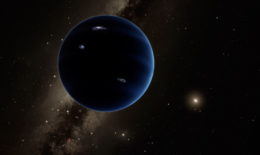Editor’s note: Astrobites is a graduate-student-run organization that digests astrophysical literature for undergraduate students. As part of the partnership between the AAS and astrobites, we occasionally repost astrobites content here at AAS Nova. We hope you enjoy this post from astrobites; the original can be viewed at astrobites.org.
Title: Exploring Trans-Neptunian Space with TESS: A Targeted Shift-Stacking Search for Planet Nine and Distant TNOs in the Galactic Plane
Authors: M. Rice, G. Laughlin
First Author’s Institution: Yale University
Status: Published in PSJ
The Transiting Exoplanet Survey Satellite (TESS), which just recently finished its primary mission to search for planets around nearby, bright stars, has also provided a treasure trove of other information for astronomers. As it stares at the sky, waiting to catch the brief flicker of a distant planet passing in front of its host star, TESS’s steady, unwavering gaze catches everything from stellar pulsations, to gamma-ray bursts, to distant solar system objects tumbling through the dark.

Artist’s rendering of the hypothetical Planet Nine in the outskirts of our solar system. [Caltech/R. Hurt, IPAC]
An image of Planet Nine could be in some of the many exposures that TESS has already taken, although likely not in plain sight. Given that TESS takes 30-minute exposures of each patch of sky, the signal from our distant solar system companion would probably be extremely weak and hard to detect. One way around this issue is to “stack” multiple exposures on top of each other. This acts to boost the signal from any faint sources in an image above any background noise from the camera. Unfortunately, even the most distant solar system bodies move across the TESS field of view between exposures. Because the object is in a different place in each image, you lose any benefit from simply stacking the images on top of each other in place.
To solve this problem, the authors of today’s paper make use of a clever technique called “shift stacking”. Although an object will appear at a different location on each exposure, one can shift the sequence of exposures in such a way that the same pixels on each image correspond to the location of the object. By doing so, the images can then be stacked and added together and an object too faint to be visible in a single image now pops out.

Figure 1: Top: An illustration of the process by which a series of images, taken at different times, are combined to convert a faint, moving source into a much brighter, single point. Bottom: When searching for an undetected source, the path on the image is unknown. In this case, the algorithm must try out different guesses for the correct trajectory. The “correct” path is the one that produces the strongest signal on the final image. [Rice & Laughlin 2020]
Trying to guess the correct path for an undetected object can be slow ordeal. One simplification, however, makes this task much easier to conquer. Most outer solar system objects move incredibly slowly because they are so far from the Sun. They move so slowly, in fact, that their motion on the sky is almost entirely dominated by the Earth’s motion. This fact really helps to narrow down the range of possible guesses for the path of any undetected body. Because the Earth’s motion dominates, a body’s path across the images depends only on its distance from the Sun, and not on the specific shape of its orbit.

Figure 2: An application of the shift-stacking technique to three previously known outer solar system bodies: Sedna (top), 2015 BP519 (middle) and TG 422 (bottom). In the leftmost column, the known orbital parameters are used to calculate the trajectory of the object on the image. Next, the trajectory of the object is guessed using both a polynomial (middle) and PCA (right) technique to model the baseline flux. In all cases, the objects are recovered. [Rice & Laughlin 2020]
Next, the authors attempt to recover these three outer solar system bodies without telling the algorithm ahead of time about the trajectories of these bodies. Instead, the algorithm tries to guess the path by maximizing the brightness of the point source in the shift-stacked images. This is shown in the middle and right hand columns of Figure 2. Here, “polynomial” and “PCA” refer to the technique used to subtract the baseline flux from the images. Although the polynomial technique is less computationally expensive, it sometimes results in the object itself being removed from the images.
Lastly, the authors apply their blind search algorithm to TESS sectors 18 and 19. Although this is only a small piece of the observing footprint of the telescope, these two sectors partially overlap with the galactic plane, which is where the shift-stacking technique is particularly useful. In total, the authors provide a list of 17 new outer solar system body candidates, which will need to be followed up with ground-based observations to confirm. From the TESS images, the distance, brightness, and size of the objects are estimated. Unfortunately, none appear anywhere near as large as what is expected for the hypothetical planet nine. It is, however, exciting that this technique finds so many new candidate objects from such a small search area. Presently, there are only about 100 known distant outer solar system bodies! Although this technique is quite computationally expensive to run, a more clever implementation that involves convolutional neural networks could allow this to be run on the entire sky.
Original astrobite edited by Bryanne McDonough.
About the author, Spencer Wallace:
I’m a member of the UW Astronomy N-body shop working with Thomas Quinn to study simulations of planet formation. In particular, I’m interested in how this process plays out around M stars, which put out huge amounts of radiation during the pre main-sequence phase and are known to host extremely short period planets. When I’m not thinking about planet formation, I’m an avid hiker/backpacker and play bass for the band Night Lunch.
